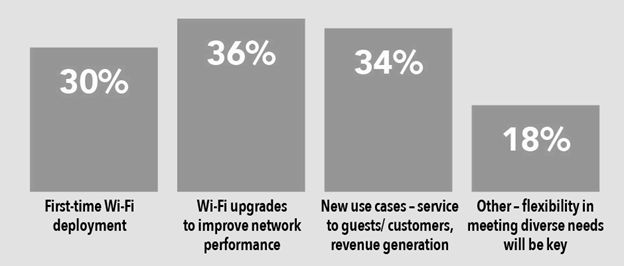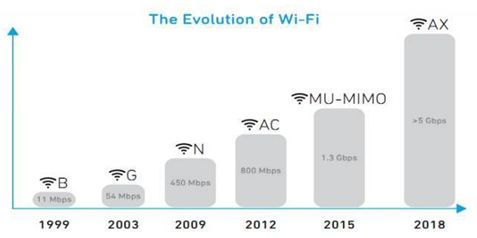Your 5 kopecks: Wi-Fi today and tomorrow

Today, smartphones or tablets can be seen at every workplace. This attribute is as essential to it as it used to be - a fountain pen, a pencil and paper. Moreover, the number of mobile devices is growing rapidly, and the deployment of corporate cloud services continues. According to Gartner, more than half of mobile data is transmitted over Wi-Fi. From 2015 to 2018, their volume is expected to grow from 52 to 173 million TB. This growth must be accompanied by reliable wireless services. Will the network infrastructure of enterprises keep up with these rapid changes? And will the office finally become wireless?
In fact, the concept is quite conditional, because the deployment of a Wi-Fi network only increases the importance of a well-designed cable infrastructure for connecting access points, printers, PCs, video surveillance cameras, servers, NAS and network equipment.

According to IDC's 2017 global survey of small businesses (less than 50 employees), 30% of respondents deployed a Wi-Fi network for the first time, 36% upgraded it to improve productivity, 34% would test new Wi-Fi usage scenarios (services for guests and clients). , new sources of profit), for 18% the key factor is the flexible possibilities of holding meetings, etc.
Meanwhile, the prospects of the “wireless office” are periodically discussed in the pages of the industry press for at least ten years. The services and products that have appeared over the past year, new wireless standards, the popularity of the BYOD concept give this topic new content, and users get new opportunities. Meanwhile, IEEE is constantly working on new 802.11 Wi-Fi standards, the number of which will soon exceed the number of letters in the alphabet.
')
Wi-Fi standards

Although 802.11ac Wave2 promises a lot, it will be extremely difficult to achieve even half of the declared speed. It should also be understood that the maximum data transfer rate with the maximum channel width is a utopia.
802.11ac network
Companies now pin their hopes on 802.11ac wireless networks, and in some industries, for example, in the hospitality industry, they are being introduced at an accelerated pace, due to the need to service more devices, cloud applications and deliver multimedia content to Netflix, support for Amazon Prime and like them. This is what the customer wants, who is always right. Therefore, Wi-Fi in hotels should be at the height and delight guests with gigabit speeds.

Increase data transfer speed (Mbps) in Wi-Fi networks.
Wave 2 and MU-MIMO technology
With the advent of the 802.11ac Wave 2 standard with impressive data transfer speeds, many vendors have considered using additional spatial streams and support for multi-user MIMO mode as an excellent solution. However, despite the significant improvements achieved in the 802.11ac Wave 2 standard, in actual practice, when deploying wireless networks, the performance jump was not as significant as when switching from 802.11n to 802.11ac.
To increase the bandwidth in 802.11ac, optimized modulation and transmission mechanisms, channel expansion (Channel Bonding), up to 4 spatial streams are used. Theoretically, the speed should exceed 802.11n times, but in practice this is unattainable . The maximum bonus is doubling the speed of 802.11n in Wave 1. But in Wave 2 it is almost three times higher.
Differences 802.11ac Wave 1 and Wave 2

Another “trick” is a dynamic change of the radiation pattern, which means that the coverage area of the access point can adapt to the current location of customers. And the MU-MIMO technology in Wave 2 allows you to split the frequency band into “subchannels” and transmit data in parallel. The bottom line is efficient use of bandwidth in networks with a large number of clients.

Traditional wireless router and router with MU-MIMO technology, supporting simultaneous connection of a large number of devices.
How to catch the wave? Much depends on your user base. Although due to the use of MU-MIMO technology (multi-user multiple-input, multiple-output), the transition to the Wave 2 standard should provide a noticeable increase in data transfer speed and network performance with a large number of users, as usual, in practice this does not always work .
Without the right combination of devices, the benefits will be negligible. End-user devices must support MU-MIMO, which gives faster connections. But when deploying a low-density wireless network optimized for coverage, users will barely notice any improvement over the 802.11ac Wave 1 access points. And if there are employees of users who don’t support MU-MIMO, then there’s no network performance decreases.

The wireless access points of the standard 802.11ac Wave 2 - NWA1123-AC HD, NWA5123-AC HD and WAC6303D-S from Zyxel - use a special signal beam forming technology that provides an increase in the data transmission rate for all client devices, including not supporting MU-MIMO. Built-in filters reduce the effects of interference from 3G / 4G cellular networks.
To overcome this problem, some Wave 2 access points use new generation technology to form a signal radiation pattern. They are also equipped with a smart antenna, eliminating the imposition of Wi-Fi signals in one channel of a heavily loaded wireless network. Thanks to these technologies, this equipment is demanded by customers. Wave 2 access points in Russia account for about 60% of the sales of all access points of corporate class leading brands.

According to the Dell'Oro forecast, by 2020, 802.11ac equipment will finally force out devices of the previous generation.
Despite the progress in how Wi-Fi networks cope with the ever-increasing demands for speed and the support of a growing number of devices, MU-MIMO simply cannot physically solve all the problems. However, in a recent study , it was shown that intelligent antenna technology effectively copes with channel alignment. In some cases, it gives a 70% average increase in total throughput compared to previous access points in the same environment under the same conditions. Tools for monitoring Wi-Fi coverage and “user experience” in real time appear. If Wi-Fi becomes the main means of communication in the workplace, then such tools are necessary.
Interference in the air
Enterprises are facing another major obstacle, already familiar to many 2.4 GHz frequencies, used by 802.11b / g / n access points and previous-generation client devices. Currently, the 5 GHz spectrum is becoming an increasingly acute interference problem, when two or more access points or other devices are working on the same channel.
When this happens, the access points interfere with each other to communicate with the connected devices, which often leads to poor performance or loss of connection. The 802.11ac and 802.11ac Wave 2 equipment operates exclusively in the 5 GHz frequency spectrum, and an increase in the data transfer rate is achieved by channel expansion. It's like on the highway when you add a few more lanes to increase its capacity.
The likelihood of problems with the channel in the corporate environment is quite high. Interference from cellular networks can also interfere with Wi-Fi transmission. To improve the performance of Wi-Fi, a new standard or 802.11 standard group called “mobility enhancements” is introduced. This initiative focuses on improving networking expertise for faster and more sustainable communication. These enhancements provide service providers and enterprises with a range of tools for Wi-Fi networks that have already been tested in cellular networks.
New standards and management methods
Various new standards relate to fast connection establishment (802.11ai), call forwarding (802.11r in combination with 802.11ai) and load balancing (802.11k / v). Many leading manufacturers are already using the 802.11r standard so that devices can move from one access point to another (seamless roaming).

The average annual growth of cloud-managed WLAN infrastructure in the period from 2013 to 2018 will be 38.8%. The turnover of the infrastructure and platform cloud services market will reach $ 32 billion this year with a 35% increase. By 2018, 60% of enterprises will transfer at least half of their infrastructure to cloud platforms. The source is IDC.
To simplify the process of upgrading and managing wireless networks, enterprises are turning to cloud services and platforms. Although the first management of infrastructure in the cloud caused a lot of skepticism, enterprises now use this strategy. According to IDC , in 2018, 60% of them will transfer at least half of their infrastructure to cloud platforms, and the market volume of cloud-controlled wireless LAN infrastructure will grow by 38.8% . For comparison, the growth forecast of the WLAN infrastructure market as a whole is 11%.
Certain hopes are also placed on artificial intelligence. The network infrastructure that can collect analytical data itself makes decisions based on them and executes them can be distributed as early as 2018. The key to this is the cloud, because it allows you to store and process data centrally.
From 802.11ac to 802.11ax
For users, the 802.11ac Wave 2 standard means a significant increase in performance and throughput of a wireless network, and new functions, including MU-MIMO, allow more devices to simultaneously interact with an access point. 802.11ac Wave 2 can quadruple performance and provide a much better experience for users. Of course, if their smartphones support it.

Growth in the number of smartphone users (billion) in the world according to eMarketer.
The corporate sector is just beginning to deploy 802.11ac Wave 2. Access points using 802.11ac Wave 2 are gradually becoming the de facto standard for enterprises, and the new 802.11ax standard promises to reduce the competition for the channel and uses the experience of building cellular networks. .
The day is near when manufacturers start preparing for the production of 802.11ax devices. The 802.11ax specifications contain an impressive set of changes that relate to the very principles of Wi-Fi operation, promise qualitative changes, and not just represent another improvement.

The evolution of Wi-Fi.
802.11ax implies a significant increase in network coverage and a number of new features. The key technology of 802.11ax is orthogonal frequency division multiple access (OFDMA). In 802.11ax MIMO goes to the next level - MIMO-OFDM. This is a transmission technology that, in essence, allows several devices to share not only one access point, but also the same Wi-Fi channel.

The potential volume of the 802.11ax equipment market (in millions of devices) in different regions according to MarketsandMarkets Analysis.
MIMO-OFDM technology (orthogonal frequency division multiplexing) will be able to create a large “pipe” for delivering large amounts of data. This will significantly increase throughput compared to 802.11ac. OFDM is already used in LTE and earlier Wi-Fi standards.
Statistics show that 802.11ax should provide a fourfold increase in speed compared to 802.11ac at the edge of the network, and the network capacity will also increase fourfold. Laboratory tests show that 802.11ax achieves maximum speeds of 10.53 Gbit / s. Another advantage of 802.11ax is the deployment of high-density Wi-Fi networks.

802.11ax - another major update for Wi-Fi networks (source - Intel). It is the successor to 802.11ac and provides four times more bandwidth.
According to analysts, by the end of 2022, 802.11ax chipsets will account for more than a quarter of all Wi-Fi chipset shipments. 802.11ax is expected to be used in new Wi-Fi applications, such as UHD video and high-density Wi-Fi user environments. 802.11ax is also aimed at solving interconnection problems between access points. This should improve the user experience in crowded frequency spectra.
Although the 802.11ax standard seems to be a major evolution, it is backward compatible, so enterprises can continue to deploy 802.11ac networks. We can also expect changes in switching mechanisms to support more devices, changes in PoE requirements for new access points.
To solve the problems with the bandwidth of Wi-Fi should have been subsequent varieties of the standard Wi-Fi: IEEE 802.11ac Wave1 and IEEE 802.11ac Wave2. The first, Wave1, provides bandwidth up to 1300 Mbit / s, but does not differ in principle from the basic version. But IEEE 802.11ac Wave2 turned out to be much more interesting. In addition to speeds up to 2600 Mbps, IEEE 802.11ac Wave2 uses MU-MIMO technology (multi-user, multi-input, multi-output), or translating into Russian, the technology allows you to increase network capacity and provide high data rates with high data rates users connected to a Wi-Fi network
However, Wi-Fi networks are becoming more and more, and they also perform a supporting function of providing Internet to mobile users. After all, no matter how hard cellular operators tried, they can only provide really high-speed access using 4G technology with a very small number of connected subscribers. Therefore, in any business centers where there are a lot of employees entering the mobile Internet, one can not hope for this technology. Only Wi-Fi networks will help out.
Why can't we do without IEEE 802.11ac Wave2?
Second, BYOD technology dictates its own rules to us - there will be more and more wireless users. And that means one thing - they all have to provide high-speed connectivity. And here, apart from IEEE 802.11ac Wave2, we have no options. Therefore, if you plan in the next year or two to develop your own Wi-Fi network, then do not be lazy to count: it is possible, today it is more profitable to invest in the equipment of a new generation, in order not to spend money on upgrading!
Most likely, this does not require the replacement of low-current cabling, although new access points may require 802.3at PoE + power. A pilot project and wireless network testing with specific applications and clients will not interfere.
What do you think, is Wi-Fi technology ready for what is called a fully mobile office environment, or do you have to wait another couple of years?
Source: https://habr.com/ru/post/348698/
All Articles